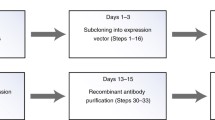Abstract
Mammalian cells are the most commonly used production system for therapeutic antibodies. Protocols for the expression of recombinant antibodies in HEK293-6E cells in different antibody formats are described in detail. As model, antibodies against Kallikrein-related peptidase 7 (KLK7) were used. KLK7 is a key player in skin homeostasis and represents an emerging target for pharmacological interventions. Potent inhibitors can not only help to elucidate physiological and pathophysiological functions but also serve as a new archetype for the treatment of inflammatory skin disorders. Phage display-derived affinity-matured human anti-KLK7 antibodies were converted to scFv-Fc, IgG, and Fab formats and transiently produced in the mammalian HEK293-6E system. For the production of the corresponding antigen—KLK7—the baculovirus expression vector system (BEVS) and virus-free expression in Hi5 insect cells were used in a comparative approach. The target proteins were isolated by various chromatographic methods in a one- or multistep purification strategy. Ultimately, the interaction between anti-KLK7 and KLK7 was characterized using biolayer interferometry. Here, protocols for the expression of recombinant antibodies in different formats are presented and compared for their specific features. Furthermore, biolayer interferometry (BLI), a fast and high-throughput biophysical analytical technique to evaluate the kinetic binding constant and affinity constant of the different anti-KLK7 antibody formats against Kallikrein-related peptidase 7 is presented.
Access this chapter
Tax calculation will be finalised at checkout
Purchases are for personal use only
Similar content being viewed by others
References
Karste K, Bleckmann M, van den Heuvel J (2017) Not limited to E. coli: versatile expression vectors for mammalian protein expression. Methods Mol Biol 1586:313–324
Meyer S, Lorenz C, Baser B et al (2013) Multi-host expression system for recombinant production of challenging proteins. PLoS One 8(7):e68674
Kamat V, Rafique A (2017) Designing binding kinetic assay on the bio-layer interferometry (BLI) biosensor to characterize antibody-antigen interactions. Anal Biochem 536:16–31
Egawa G, Kabashima K (2018) Barrier dysfunction in the skin allergy. Allergol Int 67:3–11
Sotiropoulou G, Pampalakis G (2012) Targeting the kallikrein-related peptidases for drug development. Trends Pharmacol Sci 33:623–634
Goettig P, Magdolen V, Brandstetter H (2010) Natural and synthetic inhibitors of kallikrein-related peptidases (klks). Biochimie 92:1546–1567
Russo G, Meier D, Helmsing S et al (2018) Parallelized antibody selection in microtiter plates. Methods Mol Biol 1701:273–284
Frenzel A, Hust M, Schirrmann T (2016) Phage display-derived antibodies in clinical development and therapy. mAbs 8:1177–1194
Strohl WR (2018) Current progress in innovative engineered antibodies. Prot Cell 9:86–120
Frenzel A, Hust M, Schirrmann T (2013) Expression of recombinant antibodies. Front Immunol 4:217
Ha J-H, Kim J-E, Kim Y-S (2016) Immunoglobulin Fc heterodimer platform technology: From design to applications in therapeutic antibodies and proteins. Front Immunol 7:394
Thie H, Toleikis L, Li J et al (2011) Rise and fall of an anti-MUC1 specific antibody. PLoS One 6:e15921
Wenzel EV, Bosnak M, Tierney R et al (2020) Human antibodies neutralizing diphtheria toxin in vitro and in vivo. Sci Rep 10:571
Li Z, Krippendorff B-F, Sharma S et al (2016) Influence of molecular size on tissue distribution of antibody fragments. mAbs 8:113–119
Khan KH (2013) Gene expression in mammalian cells and its applications. Adv Pharm Bull 3:257–263
Jäger V, Büssow K, Wagner A et al (2013) High level transient production of recombinant antibodies and antibody fusion proteins in HEK293 cells. BMC Biotechnol 13:52
Li MZ, Elledge SJ (2012) SLIC: a method for sequence- and ligation-independent cloning. Methods Mol Biol 852:51–59
Fühner V, Heine PA, Helmsing S et al (2018) Development of neutralizing and non-neutralizing antibodies targeting known and novel epitopes of TCDB of Clostridioides difficile. Front Microbiol 9:2908
Kumaraswamy S, Tobias R (2015) Label-Free kinetic analysis of an antibody-antigen interaction using biolayer interferometry. Methods Mol Biol 1278:165–182
Bleckmann M, Schürig M, Chen FF et al (2016) Identification of essential genetic baculoviral elements for recombinant protein expression by transactivation in Sf21 insect cells. PloS One 11:e0149424
Shen X, Pitol AK, Bachmann V et al (2015) A simple plasmid-based transient gene expression method using High Five cells. J Biotechnol 216:67–75
Stolt-Bergner P, Benda C, Bergbrede T et al (2018) Baculovirus-driven protein expression in insect cells: a benchmarking study. J Struct Biol 203:71–80
Acknowledgments
We greatly thank Luciano Puzer from the Universidade Federal do ABC, Sao Paulo, Brazil for his valuable scientific input and the biomaterials he made available for this research project. We also thank Daniela Gebauer, Nadine Konisch, and Anke Samuels for their excellent technical support during the experiments. This work was supported by the Helmholtz Protein Sample Production Facility (PSPF).
Author information
Authors and Affiliations
Corresponding author
Editor information
Editors and Affiliations
Rights and permissions
Copyright information
© 2021 Springer Science+Business Media, LLC, part of Springer Nature
About this protocol
Cite this protocol
König, J., Hust, M., van den Heuvel, J. (2021). Validation of the Production of Antibodies in Different Formats in the HEK 293 Transient Gene Expression System. In: Poterszman, A. (eds) Multiprotein Complexes. Methods in Molecular Biology, vol 2247. Humana, New York, NY. https://doi.org/10.1007/978-1-0716-1126-5_4
Download citation
DOI: https://doi.org/10.1007/978-1-0716-1126-5_4
Published:
Publisher Name: Humana, New York, NY
Print ISBN: 978-1-0716-1125-8
Online ISBN: 978-1-0716-1126-5
eBook Packages: Springer Protocols




